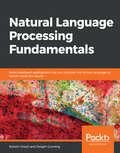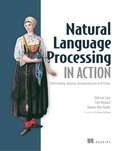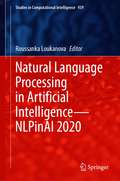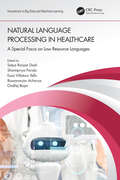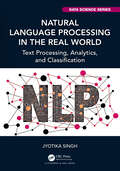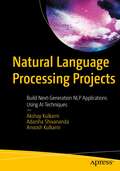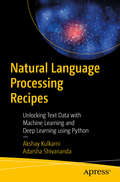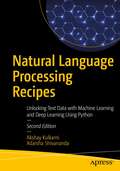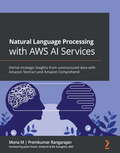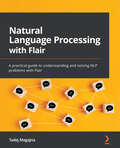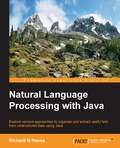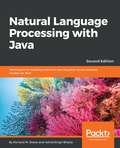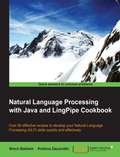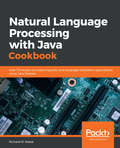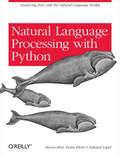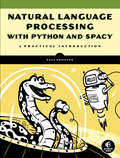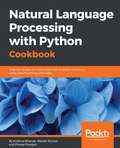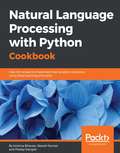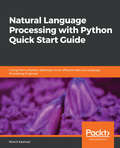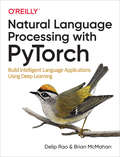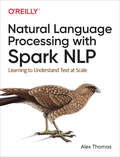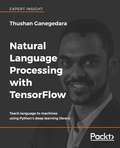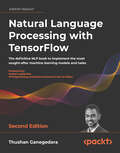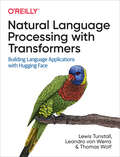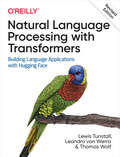- Table View
- List View
Natural Language Processing Fundamentals: Build intelligent applications that can interpret the human language to deliver impactful results
by Dwight Gunning Sy Hwang Dongjun JungNatural Language Processing Fundamentals is designed for novice and mid-level data scientists and machine learning developers, who want to gather and analyze text data to build an NLP-powered product. It'll help you to have prior experience of coding in Python - using data types, writing functions, and importing libraries. Some experience with linguistics and probability is useful but is not necessary.
Natural Language Processing in Action: Understanding, analyzing, and generating text with Python
by Hannes Hapke Cole Howard Hobson LaneSummaryNatural Language Processing in Action is your guide to creating machines that understand human language using the power of Python with its ecosystem of packages dedicated to NLP and AI.Purchase of the print book includes a free eBook in PDF, Kindle, and ePub formats from Manning Publications.About the TechnologyRecent advances in deep learning empower applications to understand text and speech with extreme accuracy. The result? Chatbots that can imitate real people, meaningful resume-to-job matches, superb predictive search, and automatically generated document summaries—all at a low cost. New techniques, along with accessible tools like Keras and TensorFlow, make professional-quality NLP easier than ever before.About the BookNatural Language Processing in Action is your guide to building machines that can read and interpret human language. In it, you'll use readily available Python packages to capture the meaning in text and react accordingly. The book expands traditional NLP approaches to include neural networks, modern deep learning algorithms, and generative techniques as you tackle real-world problems like extracting dates and names, composing text, and answering free-form questions.What's insideSome sentences in this book were written by NLP! Can you guess which ones?Working with Keras, TensorFlow, gensim, and scikit-learnRule-based and data-based NLPScalable pipelinesAbout the ReaderThis book requires a basic understanding of deep learning and intermediate Python skills.About the AuthorHobson Lane, Cole Howard, and Hannes Max Hapke are experienced NLP engineers who use these techniques in production.Table of ContentsPART 1 - WORDY MACHINESPackets of thought (NLP overview)Build your vocabulary (word tokenization)Math with words (TF-IDF vectors)Finding meaning in word counts (semantic analysis)PART 2 - DEEPER LEARNING (NEURAL NETWORKS)Baby steps with neural networks (perceptrons and backpropagation)Reasoning with word vectors (Word2vec)Getting words in order with convolutional neural networks (CNNs)Loopy (recurrent) neural networks (RNNs)Improving retention with long short-term memory networksSequence-to-sequence models and attentionPART 3 - GETTING REAL (REAL-WORLD NLP CHALLENGES)Information extraction (named entity extraction and question answering)Getting chatty (dialog engines)Scaling up (optimization, parallelization, and batch processing)
Natural Language Processing in Artificial Intelligence—NLPinAI 2020 (Studies in Computational Intelligence #939)
by Roussanka LoukanovaThis book covers theoretical work, applications, approaches, and techniques for computational models of information and its presentation by language (artificial, human, or natural in other ways). Computational and technological developments that incorporate natural language are proliferating. Adequate coverage encounters difficult problems related to ambiguities and dependency on context and agents (humans or computational systems). The goal is to promote computational systems of intelligent natural language processing and related models of computation, language, thought, mental states, reasoning, and other cognitive processes.
Natural Language Processing In Healthcare: A Special Focus on Low Resource Languages (Innovations in Big Data and Machine Learning)
by Satya Ranjan Dash Shantipriya Parida Esaú Villatoro Tello Biswaranjan Acharya Ondřej BojarNatural Language Processing In Healthcare: A Special Focus on Low Resource Languages covers the theoretical and practical aspects as well as ethical and social implications of NLP in healthcare. It showcases the latest research and developments contributing to the rising awareness and importance of maintaining linguistic diversity. The book goes on to present current advances and scenarios based on solutions in healthcare and low resource languages and identifies the major challenges and opportunities that will impact NLP in clinical practice and health studies.
Natural Language Processing in the Real World: Text Processing, Analytics, and Classification (Chapman & Hall/CRC Data Science Series)
by Jyotika SinghNatural Language Processing in the Real World is a practical guide for applying data science and machine learning to build Natural Language Processing (NLP) solutions. Where traditional, academic-taught NLP is often accompanied by a data source or dataset to aid solution building, this book is situated in the real world where there may not be an existing rich dataset. This book covers the basic concepts behind NLP and text processing and discusses the applications across 15 industry verticals. From data sources and extraction to transformation and modelling, and classic Machine Learning to Deep Learning and Transformers, several popular applications of NLP are discussed and implemented. This book provides a hands-on and holistic guide for anyone looking to build NLP solutions, from students of Computer Science to those involved in large-scale industrial projects.
Natural Language Processing Projects: Build Next-Generation NLP Applications Using AI Techniques
by Akshay Kulkarni Adarsha Shivananda Anoosh KulkarniLeverage machine learning and deep learning techniques to build fully-fledged natural language processing (NLP) projects. Projects throughout this book grow in complexity and showcase methodologies, optimizing tips, and tricks to solve various business problems. You will use modern Python libraries and algorithms to build end-to-end NLP projects. The book starts with an overview of natural language processing (NLP) and artificial intelligence to provide a quick refresher on algorithms. Next, it covers end-to-end NLP projects beginning with traditional algorithms and projects such as customer review sentiment and emotion detection, topic modeling, and document clustering. From there, it delves into e-commerce related projects such as product categorization using the description of the product, a search engine to retrieve the relevant content, and a content-based recommendation system to enhance user experience. Moving forward, it explains how to build systems to find similar sentences using contextual embedding, summarizing huge documents using recurrent neural networks (RNN), automatic word suggestion using long short-term memory networks (LSTM), and how to build a chatbot using transfer learning. It concludes with an exploration of next-generation AI and algorithms in the research space. By the end of this book, you will have the knowledge needed to solve various business problems using NLP techniques.What You Will LearnImplement full-fledged intelligent NLP applications with PythonTranslate real-world business problem on text data with NLP techniquesLeverage machine learning and deep learning techniques to perform smart language processingGain hands-on experience implementing end-to-end search engine information retrieval, text summarization, chatbots, text generation, document clustering and product classification, and more Who This Book Is ForData scientists, machine learning engineers, and deep learning professionals looking to build natural language applications using Python
Natural Language Processing Recipes: Unlocking Text Data with Machine Learning and Deep Learning using Python
by Akshay Kulkarni Adarsha ShivanandaImplement natural language processing applications with Python using a problem-solution approach. This book has numerous coding exercises that will help you to quickly deploy natural language processing techniques, such as text classification, parts of speech identification, topic modeling, text summarization, text generation, entity extraction, and sentiment analysis. Natural Language Processing Recipes starts by offering solutions for cleaning and preprocessing text data and ways to analyze it with advanced algorithms. You’ll see practical applications of the semantic as well as syntactic analysis of text, as well as complex natural language processing approaches that involve text normalization, advanced preprocessing, POS tagging, and sentiment analysis. You will also learn various applications of machine learning and deep learning in natural language processing.By using the recipes in this book, you will have a toolbox of solutions to apply to your own projects in the real world, making your development time quicker and more efficient. What You Will LearnApply NLP techniques using Python libraries such as NLTK, TextBlob, spaCy, Stanford CoreNLP, and many moreImplement the concepts of information retrieval, text summarization, sentiment analysis, and other advanced natural language processing techniques.Identify machine learning and deep learning techniques for natural language processing and natural language generation problemsWho This Book Is ForData scientists who want to refresh and learn various concepts of natural language processing through coding exercises.
Natural Language Processing Recipes: Unlocking Text Data with Machine Learning and Deep Learning Using Python
by Akshay Kulkarni Adarsha ShivanandaFocus on implementing end-to-end projects using Python and leverage state-of-the-art algorithms. This book teaches you to efficiently use a wide range of natural language processing (NLP) packages to: implement text classification, identify parts of speech, utilize topic modeling, text summarization, sentiment analysis, information retrieval, and many more applications of NLP. The book begins with text data collection, web scraping, and the different types of data sources. It explains how to clean and pre-process text data, and offers ways to analyze data with advanced algorithms. You then explore semantic and syntactic analysis of the text. Complex NLP solutions that involve text normalization are covered along with advanced pre-processing methods, POS tagging, parsing, text summarization, sentiment analysis, word2vec, seq2seq, and much more. The book presents the fundamentals necessary for applications of machine learning and deep learning in NLP. This second edition goes over advanced techniques to convert text to features such as Glove, Elmo, Bert, etc. It also includes an understanding of how transformers work, taking sentence BERT and GPT as examples. The final chapters explain advanced industrial applications of NLP with solution implementation and leveraging the power of deep learning techniques for NLP problems. It also employs state-of-the-art advanced RNNs, such as long short-term memory, to solve complex text generation tasks. After reading this book, you will have a clear understanding of the challenges faced by different industries and you will have worked on multiple examples of implementing NLP in the real world.What You Will LearnKnow the core concepts of implementing NLP and various approaches to natural language processing (NLP), including NLP using Python libraries such as NLTK, textblob, SpaCy, Standford CoreNLP, and moreImplement text pre-processing and feature engineering in NLP, including advanced methods of feature engineeringUnderstand and implement the concepts of information retrieval, text summarization, sentiment analysis, text classification, and other advanced NLP techniques leveraging machine learning and deep learningWho This Book Is ForData scientists who want to refresh and learn various concepts of natural language processing (NLP) through coding exercises
Natural Language Processing with AWS AI Services: Derive strategic insights from unstructured data with Amazon Textract and Amazon Comprehend
by Mona M Premkumar Rangarajan Julien SimonWork through interesting real-life business use cases to uncover valuable insights from unstructured text using AWS AI servicesKey FeaturesGet to grips with AWS AI services for NLP and find out how to use them to gain strategic insightsRun Python code to use Amazon Textract and Amazon Comprehend to accelerate business outcomesUnderstand how you can integrate human-in-the-loop for custom NLP use cases with Amazon A2IBook DescriptionNatural language processing (NLP) uses machine learning to extract information from unstructured data. This book will help you to move quickly from business questions to high-performance models in production.To start with, you'll understand the importance of NLP in today's business applications and learn the features of Amazon Comprehend and Amazon Textract to build NLP models using Python and Jupyter Notebooks. The book then shows you how to integrate AI in applications for accelerating business outcomes with just a few lines of code. Throughout the book, you'll cover use cases such as smart text search, setting up compliance and controls when processing confidential documents, real-time text analytics, and much more to understand various NLP scenarios. You'll deploy and monitor scalable NLP models in production for real-time and batch requirements. As you advance, you'll explore strategies for including humans in the loop for different purposes in a document processing workflow. Moreover, you'll learn best practices for auto-scaling your NLP inference for enterprise traffic.Whether you're new to ML or an experienced practitioner, by the end of this NLP book, you'll have the confidence to use AWS AI services to build powerful NLP applications.What you will learnAutomate various NLP workflows on AWS to accelerate business outcomesUse Amazon Textract for text, tables, and handwriting recognition from images and PDF filesGain insights from unstructured text in the form of sentiment analysis, topic modeling, and more using Amazon ComprehendSet up end-to-end document processing pipelines to understand the role of humans in the loopDevelop NLP-based intelligent search solutions with just a few lines of codeCreate both real-time and batch document processing pipelines using PythonWho this book is forIf you're an NLP developer or data scientist looking to get started with AWS AI services to implement various NLP scenarios quickly, this book is for you. It will show you how easy it is to integrate AI in applications with just a few lines of code. A basic understanding of machine learning (ML) concepts is necessary to understand the concepts covered. Experience with Jupyter notebooks and Python will be helpful.
Natural Language Processing with Flair: A practical guide to understanding and solving NLP problems with Flair
by Tadej MagajnaLearn how to solve practical NLP problems with the Flair Python framework, train sequence labeling models, work with text classifiers and word embeddings, and much more through hands-on practical exercisesKey FeaturesBacked by the community and written by an NLP expertGet an understanding of basic NLP problems and terminologySolve real-world NLP problems with Flair with the help of practical hands-on exercisesBook DescriptionFlair is an easy-to-understand natural language processing (NLP) framework designed to facilitate training and distribution of state-of-the-art NLP models for named entity recognition, part-of-speech tagging, and text classification. Flair is also a text embedding library for combining different types of embeddings, such as document embeddings, Transformer embeddings, and the proposed Flair embeddings.Natural Language Processing with Flair takes a hands-on approach to explaining and solving real-world NLP problems. You'll begin by installing Flair and learning about the basic NLP concepts and terminology. You will explore Flair's extensive features, such as sequence tagging, text classification, and word embeddings, through practical exercises. As you advance, you will train your own sequence labeling and text classification models and learn how to use hyperparameter tuning in order to choose the right training parameters. You will learn about the idea behind one-shot and few-shot learning through a novel text classification technique TARS. Finally, you will solve several real-world NLP problems through hands-on exercises, as well as learn how to deploy Flair models to production.By the end of this Flair book, you'll have developed a thorough understanding of typical NLP problems and you'll be able to solve them with Flair.What you will learnGain an understanding of core NLP terminology and conceptsGet to grips with the capabilities of the Flair NLP frameworkFind out how to use Flair's state-of-the-art pre-built modelsBuild custom sequence labeling models, embeddings, and classifiersLearn about a novel text classification technique called TARSDiscover how to build applications with Flair and how to deploy them to productionWho this book is forThis Flair NLP book is for anyone who wants to learn about NLP through one of the most beginner-friendly, yet powerful Python NLP libraries out there. Software engineering students, developers, data scientists, and anyone who is transitioning into NLP and is interested in learning about practical approaches to solving problems with Flair will find this book useful. The book, however, is not recommended for readers aiming to get an in-depth theoretical understanding of the mathematics behind NLP. Beginner-level knowledge of Python programming is required to get the most out of this book.
Natural Language Processing with Java
by Richard M ReeseIf you are a Java programmer who wants to learn about the fundamental tasks underlying natural language processing, this book is for you. You will be able to identify and use NLP tasks for many common problems, and integrate them in your applications to solve more difficult problems. Readers should be familiar/experienced with Java software development.
Natural Language Processing with Java: Techniques for building machine learning and neural network models for NLP, 2nd Edition
by Richard M. Reese AshishSingh BhatiaExplore various approaches to organize and extract useful text from unstructured data using JavaKey FeaturesUse deep learning and NLP techniques in Java to discover hidden insights in textWork with popular Java libraries such as CoreNLP, OpenNLP, and MalletExplore machine translation, identifying parts of speech, and topic modelingBook DescriptionNatural Language Processing (NLP) allows you to take any sentence and identify patterns, special names, company names, and more. The second edition of Natural Language Processing with Java teaches you how to perform language analysis with the help of Java libraries, while constantly gaining insights from the outcomes.You’ll start by understanding how NLP and its various concepts work. Having got to grips with the basics, you’ll explore important tools and libraries in Java for NLP, such as CoreNLP, OpenNLP, Neuroph, and Mallet. You’ll then start performing NLP on different inputs and tasks, such as tokenization, model training, parts-of-speech and parsing trees. You’ll learn about statistical machine translation, summarization, dialog systems, complex searches, supervised and unsupervised NLP, and more.By the end of this book, you’ll have learned more about NLP, neural networks, and various other trained models in Java for enhancing the performance of NLP applications.What you will learnUnderstand basic NLP tasks and how they relate to one anotherDiscover and use the available tokenization enginesApply search techniques to find people, as well as things, within a documentConstruct solutions to identify parts of speech within sentencesUse parsers to extract relationships between elements of a documentIdentify topics in a set of documentsExplore topic modeling from a documentWho this book is forNatural Language Processing with Java is for you if you are a data analyst, data scientist, or machine learning engineer who wants to extract information from a language using Java. Knowledge of Java programming is needed, while a basic understanding of statistics will be useful but not mandatory.
Natural Language Processing with Java and LingPipe Cookbook
by Breck Baldwin Krishna DayanidhiThis book is for experienced Java developers with NLP needs, whether academics, industrialists, or hobbyists. A basic knowledge of NLP terminology will be beneficial.
Natural Language Processing with Java Cookbook: Over 70 recipes to create linguistic and language translation applications using Java libraries
by Richard M. ReeseA problem-solution guide to encounter various NLP tasks utilizing Java open source libraries and cloud-based solutionsKey FeaturesPerform simple-to-complex NLP text processing tasks using modern Java libraries Extract relationships between different text complexities using a problem-solution approach Utilize cloud-based APIs to perform machine translation operationsBook DescriptionNatural Language Processing (NLP) has become one of the prime technologies for processing very large amounts of unstructured data from disparate information sources. This book includes a wide set of recipes and quick methods that solve challenges in text syntax, semantics, and speech tasks. At the beginning of the book, you'll learn important NLP techniques, such as identifying parts of speech, tagging words, and analyzing word semantics. You will learn how to perform lexical analysis and use machine learning techniques to speed up NLP operations. With independent recipes, you will explore techniques for customizing your existing NLP engines/models using Java libraries such as OpenNLP and the Stanford NLP library. You will also learn how to use NLP processing features from cloud-based sources, including Google and Amazon’s AWS. You will master core tasks, such as stemming, lemmatization, part-of-speech tagging, and named entity recognition. You will also learn about sentiment analysis, semantic text similarity, language identification, machine translation, and text summarization. By the end of this book, you will be ready to become a professional NLP expert using a problem-solution approach to analyze any sort of text, sentences, or semantic words.What you will learnExplore how to use tokenizers in NLP processing Implement NLP techniques in machine learning and deep learning applications Identify sentences within the text and learn how to train specialized NER models Learn how to classify documents and perform sentiment analysis Find semantic similarities between text elements and extract text from a variety of sources Preprocess text from a variety of data sources Learn how to identify and translate languagesWho this book is forThis book is for data scientists, NLP engineers, and machine learning developers who want to perform their work on linguistic applications faster with the use of popular libraries on JVM machines. This book will help you build real-world NLP applications using a recipe-based approach. Prior knowledge of Natural Language Processing basics and Java programming is expected.
Natural Language Processing with Python: Analyzing Text with the Natural Language Toolkit
by Ewan Klein Edward Loper Steven BirdThis book offers a highly accessible introduction to natural language processing, the field that supports a variety of language technologies, from predictive text and email filtering to automatic summarization and translation. With it, you'll learn how to write Python programs that work with large collections of unstructured text. You'll access richly annotated datasets using a comprehensive range of linguistic data structures, and you'll understand the main algorithms for analyzing the content and structure of written communication. Packed with examples and exercises, Natural Language Processing with Python will help you:Extract information from unstructured text, either to guess the topic or identify "named entities" Analyze linguistic structure in text, including parsing and semantic analysis Access popular linguistic databases, including WordNet and treebanks Integrate techniques drawn from fields as diverse as linguistics and artificial intelligence This book will help you gain practical skills in natural language processing using the Python programming language and the Natural Language Toolkit (NLTK) open source library. If you're interested in developing web applications, analyzing multilingual news sources, or documenting endangered languages -- or if you're simply curious to have a programmer's perspective on how human language works -- you'll find Natural Language Processing with Python both fascinating and immensely useful.
Natural Language Processing with Python and spaCy: A Practical Introduction
by Yuli VasilievAn introduction to natural language processing with Python using spaCy, a leading Python natural language processing library.Natural Language Processing with Python and spaCy will show you how to create NLP applications like chatbots, text-condensing scripts, and order-processing tools quickly and easily. You'll learn how to leverage the spaCy library to extract meaning from text intelligently; how to determine the relationships between words in a sentence (syntactic dependency parsing); identify nouns, verbs, and other parts of speech (part-of-speech tagging); and sort proper nouns into categories like people, organizations, and locations (named entity recognizing). You'll even learn how to transform statements into questions to keep a conversation going.You'll also learn how to: • Work with word vectors to mathematically find words with similar meanings (Chapter 5) • Identify patterns within data using spaCy's built-in displaCy visualizer (Chapter 7) • Automatically extract keywords from user input and store them in a relational database (Chapter 9) • Deploy a chatbot app to interact with users over the internet (Chapter 11)"Try This" sections in each chapter encourage you to practice what you've learned by expanding the book's example scripts to handle a wider range of inputs, add error handling, and build professional-quality applications.By the end of the book, you'll be creating your own NLP applications with Python and spaCy.
Natural Language Processing with Python Cookbook
by Krishna Bhavsar<P><P>Learn the tricks and tips that will help you design Text Analytics solutions <P><P>Key Features <P><P>Independent recipes that will teach you how to efficiently perform Natural Language Processing in Python <P><P>Use dictionaries to create your own named entities using this easy-to-follow guide <P><P>Learn how to implement NLTK for various scenarios with the help of example-rich recipes to take you beyond basic Natural Language Processing <P><P>Book Description <P><P>Natural Language Processing (NLP) is a field of computer science, artificial intelligence, and computational linguistics concerned with the interactions between computers and human (natural) languages; in particular, it's about programming computers to fruitfully process large natural language corpora. <P><P>This book includes unique recipes that will teach you various aspects of performing Natural Language Processing with NLTK the leading Python platform for the task. You will come across various recipes during the course, covering (among other topics) natural language understanding, Natural Language Processing, and syntactic analysis. You will learn how to understand language, plan sentences, and work around various ambiguities. You will learn how to efficiently use NLTK and implement text classification, identify parts of speech, tag words, and more. You will also learn how to analyze sentence structures and master lexical analysis, syntactic and semantic analysis, pragmatic analysis, and the application of deep learning techniques. <P><P>By the end of this book, you will have all the knowledge you need to implement Natural Language Processing with Python. <P><P>What You Will Learn <P><P>Explore corpus management using internal and external corpora <P><P>Learn WordNet usage and a couple of simple application assignments using WordNet <P><P>Operate on raw text <P><P>Learn to perform tokenization, stemming, lemmatization, and spelling corrections, stop words removals, and more <P><P>Understand regular expressions for pattern matching <P><P>Learn to use and write your own POS taggers and grammars <P><P>Learn to evaluate your own trained models <P><P>Explore Deep Learning techniques in NLP <P><P>Generate Text from Nietzsche's writing using LSTM <P><P>Utilize the BABI dataset and LSTM to model episodes
Natural Language Processing with Python Cookbook
by Pratap Dangeti Krishna Bhavsar Naresh KumarLearn the tricks and tips that will help you design Text Analytics solutions About This Book • Independent recipes that will teach you how to efficiently perform Natural Language Processing in Python • Use dictionaries to create your own named entities using this easy-to-follow guide • Learn how to implement NLTK for various scenarios with the help of example-rich recipes to take you beyond basic Natural Language Processing Who This Book Is For This book is intended for data scientists, data analysts, and data science professionals who want to upgrade their existing skills to implement advanced text analytics using NLP. Some basic knowledge of Natural Language Processing is recommended. What You Will Learn • Explore corpus management using internal and external corpora • Learn WordNet usage and a couple of simple application assignments using WordNet • Operate on raw text • Learn to perform tokenization, stemming, lemmatization, and spelling corrections, stop words removals, and more • Understand regular expressions for pattern matching • Learn to use and write your own POS taggers and grammars • Learn to evaluate your own trained models • Explore Deep Learning techniques in NLP • Generate Text from Nietzsche's writing using LSTM • Utilize the BABI dataset and LSTM to model episodes In Detail Natural Language Processing (NLP) is a field of computer science, artificial intelligence, and computational linguistics concerned with the interactions between computers and human (natural) languages; in particular, it's about programming computers to fruitfully process large natural language corpora. This book includes unique recipes that will teach you various aspects of performing Natural Language Processing with NLTK—the leading Python platform for the task. You will come across various recipes during the course, covering (among other topics) natural language understanding, Natural Language Processing, and syntactic analysis. You will learn how to understand language, plan sentences, and work around various ambiguities. You will learn how to efficiently use NLTK and implement text classification, identify parts of speech, tag words, and more. You will also learn how to analyze sentence structures and master lexical analysis, syntactic and semantic analysis, pragmatic analysis, and the application of deep learning techniques. By the end of this book, you will have all the knowledge you need to implement Natural Language Processing with Python. Style and Approach This book's rich collection of recipes will come in handy when you are working with Natural Language Processing with Python. Addressing your common and not-so-common pain points, this is a book that you must have on the shelf.
Natural Language Processing with Python Quick Start Guide: Going from a Python developer to an effective Natural Language Processing Engineer
by Nirant KasliwalBuild and deploy intelligent applications for natural language processing with Python by using industry standard tools and recently popular methods in deep learningKey FeaturesA no-math, code-driven programmer’s guide to text processing and NLPGet state of the art results with modern tooling across linguistics, text vectors and machine learningFundamentals of NLP methods from spaCy, gensim, scikit-learn and PyTorchBook DescriptionNLP in Python is among the most sought after skills among data scientists. With code and relevant case studies, this book will show how you can use industry-grade tools to implement NLP programs capable of learning from relevant data. We will explore many modern methods ranging from spaCy to word vectors that have reinvented NLP.The book takes you from the basics of NLP to building text processing applications. We start with an introduction to the basic vocabulary along with a workflow for building NLP applications.We use industry-grade NLP tools for cleaning and pre-processing text, automatic question and answer generation using linguistics, text embedding, text classifier, and building a chatbot. With each project, you will learn a new concept of NLP. You will learn about entity recognition, part of speech tagging and dependency parsing for Q and A. We use text embedding for both clustering documents and making chatbots, and then build classifiers using scikit-learn.We conclude by deploying these models as REST APIs with Flask.By the end, you will be confident building NLP applications, and know exactly what to look for when approaching new challenges.What you will learnUnderstand classical linguistics in using English grammar for automatically generating questions and answers from a free text corpusWork with text embedding models for dense number representations of words, subwords and characters in the English language for exploring document clusteringDeep Learning in NLP using PyTorch with a code-driven introduction to PyTorchUsing an NLP project management Framework for estimating timelines and organizing your project into stagesHack and build a simple chatbot application in 30 minutesDeploy an NLP or machine learning application using Flask as RESTFUL APIsWho this book is forProgrammers who wish to build systems that can interpret language. Exposure to Python programming is required. Familiarity with NLP or machine learning vocabulary will be helpful, but not mandatory.
Natural Language Processing with PyTorch: Build Intelligent Language Applications Using Deep Learning
by Delip Rao Brian McMahanNatural Language Processing (NLP) provides boundless opportunities for solving problems in artificial intelligence, making products such as Amazon Alexa and Google Translate possible. If you’re a developer or data scientist new to NLP and deep learning, this practical guide shows you how to apply these methods using PyTorch, a Python-based deep learning library.Authors Delip Rao and Brian McMahon provide you with a solid grounding in NLP and deep learning algorithms and demonstrate how to use PyTorch to build applications involving rich representations of text specific to the problems you face. Each chapter includes several code examples and illustrations.Explore computational graphs and the supervised learning paradigmMaster the basics of the PyTorch optimized tensor manipulation libraryGet an overview of traditional NLP concepts and methodsLearn the basic ideas involved in building neural networksUse embeddings to represent words, sentences, documents, and other featuresExplore sequence prediction and generate sequence-to-sequence modelsLearn design patterns for building production NLP systems
Natural Language Processing with Spark NLP: Learning to Understand Text at Scale
by Alex ThomasIf you want to build an enterprise-quality application that uses natural language text but aren’t sure where to begin or what tools to use, this practical guide will help get you started. Alex Thomas, principal data scientist at Wisecube, shows software engineers and data scientists how to build scalable natural language processing (NLP) applications using deep learning and the Apache Spark NLP library.Through concrete examples, practical and theoretical explanations, and hands-on exercises for using NLP on the Spark processing framework, this book teaches you everything from basic linguistics and writing systems to sentiment analysis and search engines. You’ll also explore special concerns for developing text-based applications, such as performance.In four sections, you’ll learn NLP basics and building blocks before diving into application and system building:Basics: Understand the fundamentals of natural language processing, NLP on Apache Stark, and deep learningBuilding blocks: Learn techniques for building NLP applications—including tokenization, sentence segmentation, and named-entity recognition—and discover how and why they workApplications: Explore the design, development, and experimentation process for building your own NLP applicationsBuilding NLP systems: Consider options for productionizing and deploying NLP models, including which human languages to support
Natural Language Processing with TensorFlow: Teach language to machines using Python's deep learning library
by Thushan GanegedaraWrite modern natural language processing applications using deep learning algorithms and TensorFlowKey Features Focuses on more efficient natural language processing using TensorFlow Covers NLP as a field in its own right to improve understanding for choosing TensorFlow tools and other deep learning approaches Provides choices for how to process and evaluate large unstructured text datasets Learn to apply the TensorFlow toolbox to specific tasks in the most interesting field in artificial intelligenceBook DescriptionNatural language processing (NLP) supplies the majority of data available to deep learning applications, while TensorFlow is the most important deep learning framework currently available. Natural Language Processing with TensorFlow brings TensorFlow and NLP together to give you invaluable tools to work with the immense volume of unstructured data in today’s data streams, and apply these tools to specific NLP tasks.Thushan Ganegedara starts by giving you a grounding in NLP and TensorFlow basics. You'll then learn how to use Word2vec, including advanced extensions, to create word embeddings that turn sequences of words into vectors accessible to deep learning algorithms. Chapters on classical deep learning algorithms, like convolutional neural networks (CNN) and recurrent neural networks (RNN), demonstrate important NLP tasks as sentence classification and language generation. You will learn how to apply high-performance RNN models, like long short-term memory (LSTM) cells, to NLP tasks. You will also explore neural machine translation and implement a neural machine translator.After reading this book, you will gain an understanding of NLP and you'll have the skills to apply TensorFlow in deep learning NLP applications, and how to perform specific NLP tasks.What you will learn Core concepts of NLP and various approaches to natural language processing How to solve NLP tasks by applying TensorFlow functions to create neural networks Strategies to process large amounts of data into word representations that can be used by deep learning applications Techniques for performing sentence classification and language generation using CNNs and RNNs About employing state-of-the art advanced RNNs, like long short-term memory, to solve complex text generation tasks How to write automatic translation programs and implement an actual neural machine translator from scratch The trends and innovations that are paving the future in NLPWho this book is forThis book is for Python developers with a strong interest in deep learning, who want to learn how to leverage TensorFlow to simplify NLP tasks. Fundamental Python skills are assumed, as well as some knowledge of machine learning and undergraduate-level calculus and linear algebra. No previous natural language processing experience required, although some background in NLP or computational linguistics will be helpful.
Natural Language Processing with TensorFlow: The definitive NLP book to implement the most sought-after machine learning models and tasks, 2nd Edition
by Thushan Ganegedara Andrei LopatenkoFrom introductory NLP tasks to Transformer models, this new edition teaches you to utilize powerful TensorFlow APIs to implement end-to-end NLP solutions driven by performant ML (Machine Learning) modelsKey FeaturesLearn to solve common NLP problems effectively with TensorFlow 2.xImplement end-to-end data pipelines guided by the underlying ML model architectureUse advanced LSTM techniques for complex data transformations, custom models and metricsBook DescriptionLearning how to solve natural language processing (NLP) problems is an important skill to master due to the explosive growth of data combined with the demand for machine learning solutions in production. Natural Language Processing with TensorFlow, Second Edition, will teach you how to solve common real-world NLP problems with a variety of deep learning model architectures. The book starts by getting readers familiar with NLP and the basics of TensorFlow. Then, it gradually teaches you different facets of TensorFlow 2.x. In the following chapters, you then learn how to generate powerful word vectors, classify text, generate new text, and generate image captions, among other exciting use-cases of real-world NLP. TensorFlow has evolved to be an ecosystem that supports a machine learning workflow through ingesting and transforming data, building models, monitoring, and productionization. We will then read text directly from files and perform the required transformations through a TensorFlow data pipeline. We will also see how to use a versatile visualization tool known as TensorBoard to visualize our models. By the end of this NLP book, you will be comfortable with using TensorFlow to build deep learning models with many different architectures, and efficiently ingest data using TensorFlow Additionally, you'll be able to confidently use TensorFlow throughout your machine learning workflow.What you will learnLearn core concepts of NLP and techniques with TensorFlowUse state-of-the-art Transformers and how they are used to solve NLP tasksPerform sentence classification and text generation using CNNs and RNNsUtilize advanced models for machine translation and image caption generationBuild end-to-end data pipelines in TensorFlowLearn interesting facts and practices related to the task at handCreate word representations of large amounts of data for deep learningWho this book is forThis book is for Python developers and programmers with a strong interest in deep learning, who want to learn how to leverage TensorFlow to simplify NLP tasks.Fundamental Python skills are assumed, as well as basic knowledge of machine learning and undergraduate-level calculus and linear algebra. No previous natural language processing experience required.
Natural Language Processing with Transformers
by Lewis Tunstall Leandro Von Werra Thomas WolfSince their introduction in 2017, transformers have quickly become the dominant architecture for achieving state-of-the-art results on a variety of natural language processing tasks. If you're a data scientist or coder, this practical book shows you how to train and scale these large models using Hugging Face Transformers, a Python-based deep learning library.Transformers have been used to write realistic news stories, improve Google Search queries, and even create chatbots that tell corny jokes. In this guide, authors Lewis Tunstall, Leandro von Werra, and Thomas Wolf, among the creators of Hugging Face Transformers, use a hands-on approach to teach you how transformers work and how to integrate them in your applications. You'll quickly learn a variety of tasks they can help you solve.Build, debug, and optimize transformer models for core NLP tasks, such as text classification, named entity recognition, and question answeringLearn how transformers can be used for cross-lingual transfer learningApply transformers in real-world scenarios where labeled data is scarceMake transformer models efficient for deployment using techniques such as distillation, pruning, and quantizationTrain transformers from scratch and learn how to scale to multiple GPUs and distributed environments
Natural Language Processing with Transformers, Revised Edition
by Lewis Tunstall Leandro Von Werra Thomas WolfSince their introduction in 2017, transformers have quickly become the dominant architecture for achieving state-of-the-art results on a variety of natural language processing tasks. If you're a data scientist or coder, this practical book -now revised in full color- shows you how to train and scale these large models using Hugging Face Transformers, a Python-based deep learning library.Transformers have been used to write realistic news stories, improve Google Search queries, and even create chatbots that tell corny jokes. In this guide, authors Lewis Tunstall, Leandro von Werra, and Thomas Wolf, among the creators of Hugging Face Transformers, use a hands-on approach to teach you how transformers work and how to integrate them in your applications. You'll quickly learn a variety of tasks they can help you solve.Build, debug, and optimize transformer models for core NLP tasks, such as text classification, named entity recognition, and question answeringLearn how transformers can be used for cross-lingual transfer learningApply transformers in real-world scenarios where labeled data is scarceMake transformer models efficient for deployment using techniques such as distillation, pruning, and quantizationTrain transformers from scratch and learn how to scale to multiple GPUs and distributed environments
